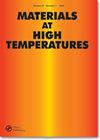渗碳抗蠕变铸件快速冷却过程中表层热应力协同分析
IF 0.9
4区 材料科学
Q4 MATERIALS SCIENCE, MULTIDISCIPLINARY
引用次数: 0
摘要
在渗碳过程中,处理过的元素在专门设计的工艺设备上输送。这种设备在特别艰苦的条件下工作。这是因为在每一个工作循环中,除了炉料所承载的负荷外,还受到炉膛高渗碳技术气氛和高且快速变化的温度等许多其他因素的有害影响。这些因素影响设备部件的疲劳变化,其可观察到的影响可能是表面裂纹,在随后的循环中向材料深处传播。影响渗碳炉设备疲劳过程动力学的关键因素是在每个工作循环中,随着每次温度变化而出现的热应力。该设备中的热应力是由加热或冷却元件截面上的温度梯度和渗碳合金结构部件的不同热膨胀引起的。本文在建立的炉内装料托盘渗碳肋次表层有限元模型的基础上,对快速冷却过程中的应力分布进行了分析。这些分析是在考虑了上述热应力源的单独影响及其同时作用的情况下进行的。在考虑温度梯度影响的分析中,主要荷载因子是在对分析截面进行热流分析的基础上确定的温度分布。所进行的分析可以评估由渗碳合金结构部件的不同热膨胀引起的局部应力对快速冷却过程中形成的温度梯度引起的全局应力分布变化的影响。基于所获得的结果,评估了碳化合金晶界特征碳化物析出物浓度的增加如何促进实际铸件中观察到的裂纹的形成,以及所分析的应力源是否对疲劳过程的动力学产生重大影响。本文章由计算机程序翻译,如有差异,请以英文原文为准。
Analysis of thermal stresses synergy in surface layer of carburised creep-resistant casts during rapid cooling processes
ABSTRACT During the carburising processes, treated elements are transported on a specially designed technological equipment of the furnaces. This equipment works in particularly hard conditions. This is because in each work cycle, apart from the load carried by the charge, it is subjected to harmful effect of many other factors such as the highly carburising technical atmosphere of the furnace and high and rapidly changing temperature. These factors influence fatigue changes in the equipment’s parts, the observable effect of which may be cracks on the surface, propagating deeper into the material in subsequent cycles. A pivotal factor influencing the kinetics of fatigue processes in the carburising furnaces equipment are thermal stresses appearing in each operating cycle, with each temperature change. The thermal stresses in this equipment are caused by the temperature gradient across the section of the heated or cooled element and different thermal expansion of the structural components of the carburised alloy. In the paper, on the developed FEM model of the subsurface layer of a carburised rib of a pallet for transporting the charge in the furnace, analyses of stress distributions during rapid cooling were carried out. These analyses were performed with taking into account the separate impact of the above-mentioned sources of thermal stresses and their simultaneous action. In the analyses which consider the influence of the temperature gradient, the main load factor was the temperature distribution determined on the basis of the heat flow analyses carried out for the analysed section of pallets rib. The conducted analyses made it possible to assess the impact of local stresses caused by different thermal expansion of structural components of the carburised alloy on the change in the distribution of global stresses caused by the temperature gradient formed during rapid cooling. Based on the obtained results, it was assessed how the increased concentration of carbide precipitates, characteristic for the grain boundary of the carburised alloy, favours the formation of cracks observed in real castings, and whether the analysed stress sources have a significant impact on the kinetics of fatigue processes.
求助全文
通过发布文献求助,成功后即可免费获取论文全文。
去求助
来源期刊

Materials at High Temperatures
工程技术-材料科学:综合
CiteScore
1.90
自引率
15.40%
发文量
58
审稿时长
>12 weeks
期刊介绍:
Materials at High Temperatures welcomes contributions relating to high temperature applications in the energy generation, aerospace, chemical and process industries. The effects of high temperatures and extreme environments on the corrosion and oxidation, fatigue, creep, strength and wear of metallic alloys, ceramics, intermetallics, and refractory and composite materials relative to these industries are covered.
Papers on the modelling of behaviour and life prediction are also welcome, provided these are validated by experimental data and explicitly linked to actual or potential applications. Contributions addressing the needs of designers and engineers (e.g. standards and codes of practice) relative to the areas of interest of this journal also fall within the scope. The term ''high temperatures'' refers to the subsequent temperatures of application and not, for example, to those of processing itself.
Materials at High Temperatures publishes regular thematic issues on topics of current interest. Proposals for issues are welcomed; please contact one of the Editors with details.
 求助内容:
求助内容: 应助结果提醒方式:
应助结果提醒方式:


